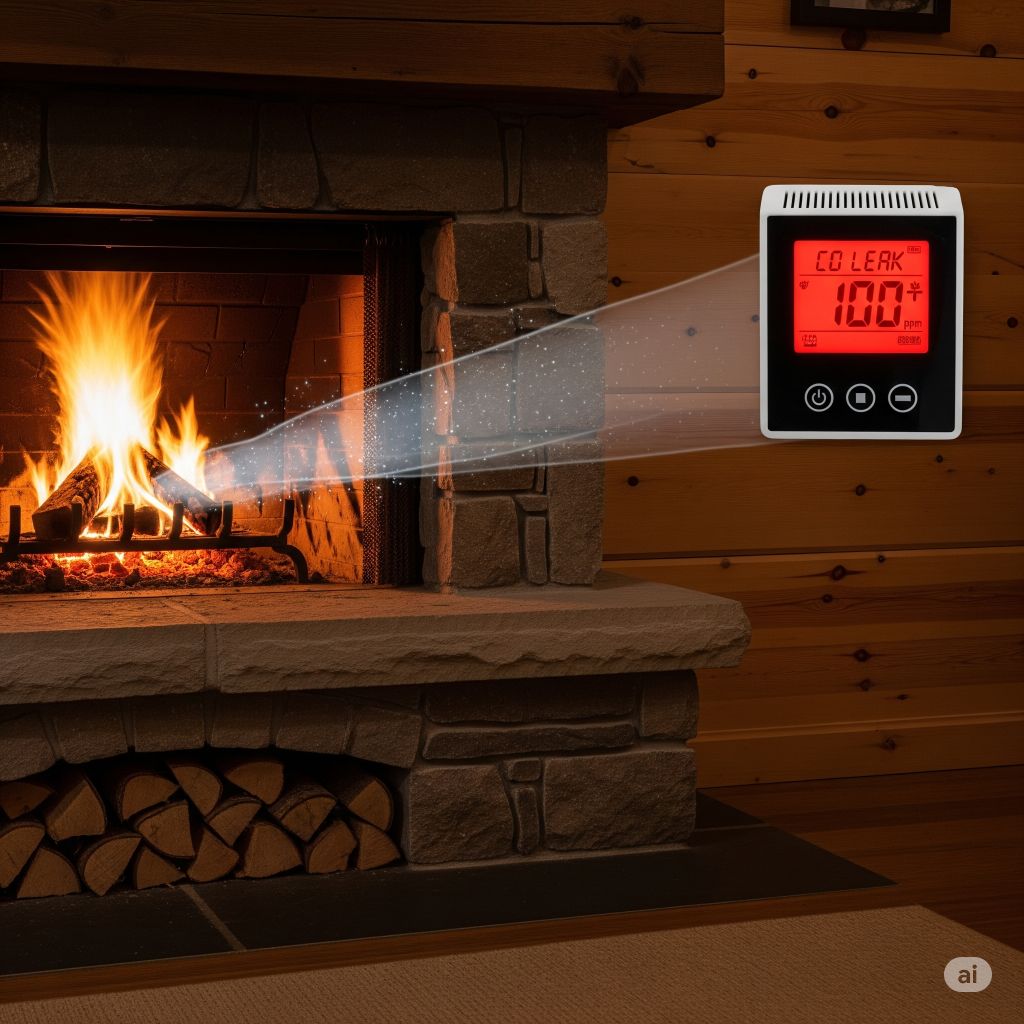
Burning wood is a common practice for heating homes and cooking meals. However, have you ever wondered if this cozy tradition produces harmful gases like carbon monoxide? In this article, I’ll delve into the question of whether burning wood releases carbon monoxide into the air.
Many people believe that burning wood is a clean and natural way to generate heat. But the reality is that wood combustion can indeed lead to the production of carbon monoxide, a colorless and odorless gas that can be dangerous if inhaled in high concentrations. Stay tuned as I uncover the facts about the relationship between burning wood and carbon monoxide emissions.
Key Takeaways
- Wood combustion produces carbon monoxide due to incomplete burning in low-oxygen environments like fireplaces and wood stoves.
- Carbon monoxide is dangerous if inhaled in high concentrations, emphasizing the need for proper ventilation when burning wood indoors.
- Inadequate oxygen during wood burning leads to the formation of colorless and odorless carbon monoxide, posing a serious health risk to individuals.
- Monitoring carbon monoxide levels, ensuring proper ventilation, and using certified appliances can reduce the risks associated with CO exposure during wood burning.
- Burning wood not only emits carbon monoxide but also releases harmful pollutants such as particulate matter and greenhouse gases, impacting both indoor and outdoor air quality.
Wood Combustion Process
When wood is burned, it undergoes a combustion process that releases various byproducts, including carbon monoxide. This occurs due to the incomplete combustion of wood in a low-oxygen environment, such as a traditional fireplace or wood stove.
During wood combustion, the heat from the fire breaks down the organic materials in the wood, releasing carbon dioxide, water vapor, and other compounds as smoke. If the fire does not receive enough oxygen for complete combustion, carbon monoxide is formed instead of carbon dioxide.
Carbon monoxide is a colorless, odorless gas that can be lethal if inhaled in high concentrations. It is crucial to ensure proper ventilation when burning wood to prevent the buildup of carbon monoxide indoors.
The Wood Combustion Process is a common source of carbon monoxide emissions, emphasizing the importance of proper ventilation and safety measures when using wood for heating and cooking.
Formation of Carbon Monoxide
When burning wood, carbon monoxide (CO) is produced as a result of incomplete combustion. Incomplete combustion occurs when there’s insufficient oxygen present for the wood to burn completely. It commonly happens in environments with limited airflow, such as wood stoves and fireplaces where ventilation may not be adequate.
Wood combustion involves a series of complex chemical reactions. As the wood heats up, various compounds break down, releasing gases like carbon dioxide, water vapor, and carbon monoxide. The presence of CO indicates that not all the carbon in the wood has been fully combusted. It’s important to note that CO is a silent killer as it’s odorless and colorless, making it hard to detect without proper monitoring equipment.
In indoor environments, the Formation of Carbon Monoxide poses a significant threat to human health. Exposure to high levels of CO can lead to symptoms like headaches, dizziness, nausea, and even death. Therefore, understanding how CO forms during wood burning is crucial for implementing preventative measures to ensure the safety of occupants in residential or commercial spaces.
Dangers of Carbon Monoxide Exposure
When it comes to the dangers of carbon monoxide (CO) exposure, it is crucial to understand the serious risks associated with this colorless, odorless gas. Exposure to high levels of CO can lead to a range of health issues, including headaches, dizziness, nausea, and even death.
Carbon monoxide poisoning can be particularly dangerous as its symptoms are often mistaken for common ailments like the flu or food poisoning, leading to delayed treatment. This is why having proper monitoring equipment in place is essential for early detection and prevention of CO-related incidents.
One alarming fact about CO is that it can interfere with the blood’s ability to carry oxygen, which can be especially harmful to individuals with pre-existing respiratory conditions or weakened immune systems. This underscores the importance of creating awareness about the risks of CO exposure and taking proactive steps to safeguard against its harmful effects.
In indoor environments where wood burning occurs, such as in wood stoves and fireplaces, the risk of CO exposure is elevated, making it crucial to implement safety measures to protect occupants. By understanding the sources and dangers of carbon monoxide, we can better equip ourselves to mitigate these risks and ensure a safer living environment for everyone.
How to Minimize Carbon Monoxide Emissions
When it comes to burning wood, it’s essential to understand the potential risks associated with carbon monoxide (CO) emissions. Here are some effective ways to minimize emissions and ensure a safer environment:
- Proper Ventilation: Ensure adequate ventilation in areas where wood burning takes place to allow CO to escape outdoors.
- Regular Maintenance: Keep chimneys, flues, and vents clean and free from blockages to prevent CO buildup.
- Use Certified Appliances: Opt for certified wood-burning stoves or fireplaces that are designed to minimize CO emissions.
- Avoid Burning Materials: Refrain from burning household waste, plastics, or treated wood as they can release harmful gases, including CO.
- Install Carbon Monoxide Detectors: Place CO detectors in key areas of your home to provide early warnings of any potential CO leaks.
By incorporating these practices into your wood burning routine, you can significantly reduce the risk of CO exposure and create a safer environment for yourself and your loved ones. Stay informed and take proactive steps to safeguard against the dangers of carbon monoxide.
Environmental Impact of Burning Wood
Burning wood does produce carbon monoxide, a colorless, odorless gas that poses serious health risks. In addition to CO, wood burning also releases other harmful pollutants into the air. The environmental impact of burning wood extends beyond just indoor air quality; it contributes to outdoor air pollution as well.
Here are some key points to consider regarding the environmental impact of burning wood:
- Particulate matter: Wood smoke contains tiny particles that can penetrate deep into the lungs and cause respiratory issues.
- Greenhouse gases: Burning wood releases carbon dioxide, a major greenhouse gas that contributes to climate change.
- Air quality: Wood burning can affect local air quality and lead to smog, which poses risks to human health and the environment.
By understanding the environmental implications of burning wood, we can make informed choices to reduce our impact and improve air quality for ourselves and future generations.
| Key Points | Data |
|---|---|
| Particulate matter | Harmful |
| Greenhouse gases | Climate-changing |
| Air quality | Local pollution |
Conclusion
Burning wood releases carbon monoxide and other pollutants, impacting both indoor and outdoor air quality. This process contributes to respiratory issues and climate change. By being aware of these effects, individuals can make informed choices to reduce their environmental impact and improve air quality for generations to come.
Frequently Asked Questions
Is burning wood bad for the environment?
Yes, burning wood can have a detrimental impact on the environment. It releases carbon monoxide and other harmful pollutants that affect both indoor and outdoor air quality, contributing to respiratory issues and climate change.
What are the key concerns associated with wood burning?
The key concerns include the release of particulate matter that can cause respiratory problems, the emission of carbon dioxide as a greenhouse gas, and the degradation of local air quality leading to smog.
How can individuals minimize the environmental impact of wood burning?
To minimize the environmental impact of wood burning, individuals can opt for cleaner burning methods, use properly seasoned wood, and ensure adequate ventilation when using wood-burning appliances. Additionally, planting trees to offset carbon emissions can help mitigate the impact.
Why is it important to understand the implications of wood burning?
It is crucial to understand the implications of wood burning to make informed choices that can reduce our environmental footprint and improve air quality for current and future generations. By being aware of the consequences, individuals can take steps to minimize the negative effects of wood burning on the environment.
